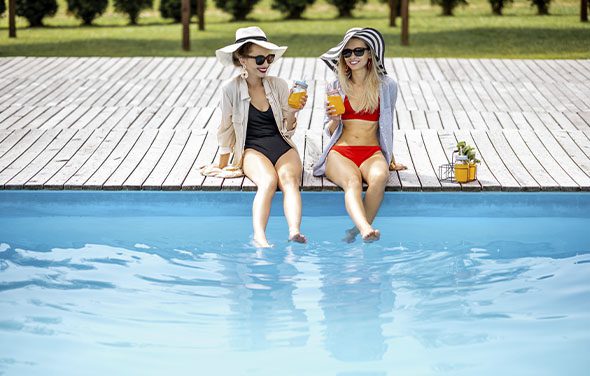Pools and Accessories
Pool maintenance and care
Having a swimming pool can be an endless source of pleasure and relaxation, but also a source of worry. With so many questions about maintenance and care, we decided to answer the most common questions that customers and followers often ask on social media.
This is the first FAQ in a series we’ve created to help you deal with pool water problems, choose equipment or decide on aesthetic aspects.
From water problems to equipment or purely decorative questions, our FAQ has never failed to help you find straightforward and accessible answers. In this article, we try to address your specific situation and explain the whole process in advance to ensure that the pool is only a blessing, not a curse. From practical solutions to expert and personal advice, we hope you’ll be enlightened by our answers.
(1) I have an above-ground swimming pool that is very green. I’m going to make shock chlorine and add shock algaecide. During actuation, should the pump be switched on or off? The pump must remain on during the application of the chemical products to ensure even distribution throughout the pool. Only turn off the pump after treatment, following the specific instructions for the products used.
2. I’m deciding on the color of the reinforced mesh for an 8x4m pool. Does anyone have a white screen? What are the advantages and disadvantages? White reinforced mesh can give the pool a cleaner, brighter appearance, highlighting the color of the water. However, it can also show dirt and stains more easily, requiring regular maintenance.
3. Which vacuum cleaner do you recommend for cleaning the waterline of a swimming pool with a white screen? We recommend a specific vacuum cleaner for the waterline, such as the Zodiac MX8 or Dolphin Supreme M5, which are effective at removing dirt accumulated in the waterline and on the surface of the pool.
4. I’m going to fill my pool this weekend. What products do you recommend? Initially, you should adjust the pH of the water to between 7.2 and 7.6. Then add chlorine for disinfection and algaecide to prevent algae growth. Use a clarifier to keep the water crystal clear and a chlorine stabilizer if the pool is exposed to the sun.
5. What is the ideal frequency for pool maintenance during the summer? During the summer, when the pool is used more frequently, it is essential to carry out regular maintenance to ensure the quality of the water and the safety of users. We recommend following these guidelines:
- Water testing: Check chlorine and pH levels at least twice a week.
- Filtration: Keep the filtration system running daily for 8-12 hours to ensure proper water circulation.
- Cleaning: Vacuum the bottom of the pool and brush the walls once a week to prevent the accumulation of debris and algae.
- Water level: Check and adjust the water level as necessary, especially after days of heavy use or rain.
- Chemical treatment: Add chlorine and other chemicals as necessary, following the manufacturer’s recommendations to maintain adequate levels.
6. I have a hydraulic vacuum cleaner and I would like to automate the opening and closing of the valves. Is it possible? Yes, it is possible to automate the valve system using motorized actuators specifically for swimming pools. These devices can be controlled by an automated control panel, similar to irrigation systems.
7. What are the main signs that the pool pump needs maintenance or replacement? The pool pump is one of the most important components for keeping the water clean and circulating. Here are some signs that the pump may need maintenance or replacement:
- Abnormal noises: If the pump starts to make strange noises, such as loud humming or squeaking, this could indicate problems with the bearings or the motor.
- Loss of power: If the pump seems to be losing power and the water is not circulating properly, there may be a problem with the impeller or obstructions in the system.
- Leaks: Any sign of water around the pump can indicate a leak in the seals or connections.
- Overheating: If the pump is getting very hot to the touch, this could be a sign of overloading or inadequate ventilation.
- Frequent shutdowns: If the pump switches itself off frequently, it could be an electrical problem or an overload protection mechanism.
8. Does an elevated swimming pool lined with decking need to be legal? Regulations may vary according to location. In general, raised pools with permanent structures or significant changes to the terrain, such as decks, may require legalization. Consult the town hall or a professional in the area for precise information.
9. For an 8x4m pool, is a height of 1.65m or 1.80m better? The ideal height depends on the user’s needs. A depth of 1.65m is sufficient for most leisure and safety activities, while 1.80m may be better for more vigorous swimming and diving. Also consider the safety of children and inexperienced swimmers.
10. I needed a vacuum cleaner that could pick up the leaves at the bottom of the pool. Any recommendations? The Zodiac RE 4400 or Dolphin Liberty 400 are good options for collecting leaves and other debris from the bottom of the pool. Make sure you choose a model that is compatible with your filtration system.
11. The purifier in my pool doesn’t have enough power to move the water. Could this be the problem? Yes, an undersized purifier may be insufficient to maintain adequate circulation and filtration, resulting in green water. Consider upgrading to a scrubber with a higher capacity or adding a clarifier to help with the initial cleaning.
12. What should I apply as flooring around the semi-finished pool? Materials such as natural stone, concrete pavers or treated wood are popular options for flooring around the pool. Choose non-slip and wear-resistant materials to ensure safety and durability.
13. My pool is green. Can it be recovered without draining the water? Yes, it is possible to restore green water using shock products such as chlorine and algaecide. Adjust the pH, apply a shock treatment and maintain continuous filtration. Regular vacuuming and cleaning is essential to remove debris and dead algae.
14. How do I check if my pool is over-chlorinated? Use a test kit to measure the level of free chlorine. The value should be between 1-3 ppm. If the levels are correct and the water is clear and does not smell strongly of chlorine, the pool is ready for use.
15. How do I solve water loss through cracks in my pool? For an economical solution, consider using a specific sealant for swimming pools, such as Piscimar AquaStop. Apply as instructed to seal small cracks. If the problem persists, consult a professional for a more detailed assessment and necessary repairs.
Thank you for reading our FAQ. I hope you’ve found answers to your questions regarding the maintenance and care of your pool. We at Pools And More are here to help you with any more specific questions. Feel free to contact us. Together, we can make your pool a source of joy and relaxation. Thank you for your confidence. Good dives!

